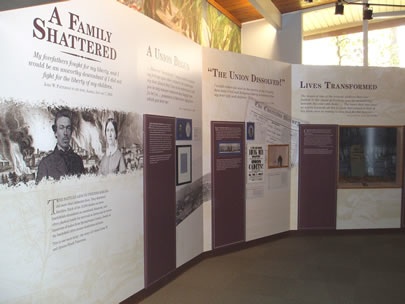
This past weekend I took a short drive out to the Chancellorsville Battlefield Visitors Center to acknowledge the 149th anniversary of the Battle of Chancellorsville (May 1-3, 1863). In addition to running an excellent film on the engagement (written by our friend John Hennessy), the CBVC museum also features some wonderful artifacts, dioramas and exhibits.
This week also marks the 148th anniversary of the Battle of the Wilderness (May 5-7, 1864). As The Wilderness Battlefield does not have its own Visitors Center, the CBVC also doubles for it.
One of the new installations (also written by John and our film-friend Donald Pfanz) tells an exceptionally tragic story from the Wilderness. The central character, John Williams Patterson, was a colonel of the 102nd Pennsylvania Volunteer Infantry who was killed May 5, 1864. According to the exhibit Patterson died the day after returning to camp from leave, and one day before his 29th birthday. He was shot as he led the regiment against attacking Confederates at the intersection of the Brock and Orange Plank roads. His body was left on the field as the regiment fell back, but was retrieved the next day.
Patterson was first buried at the 6th Corps field hospital. In 1865 his body was moved to Wilderness Cemetery No. 2, near where he received his fatal wound. In 1869, when the cemetery was emptied for transfer of the bodies to Fredericksburg, Patterson’s was taken north to Pennsylvania and reburied in the Southside Cemetery. (The preserved grave marker that is on display had also arrived in Pittsburgh with the body. The board reads, in black ink, “Col. Jno. W. Patterson, 102 Pa., Killed May 1864.”)
The exhibit is titled “A Family Shattered” and features photographs, letters and other items preserved by Patterson’s descendants. These include an 1861 recruiting poster; two flasks; a bullet that apparently passed through Patterson’s chest at the Battle of Fair Oaks and a poster from the Orphan’s Court, advertising the sale of the Patterson home when his death left his wife and children destitute.
The loss of Col. Patterson financially devastated his family, leaving them in near-poverty. His wife, Almira, had a widow’s pension of about $360 per year. Although Patterson had owned his house free and clear, the Allegheny County, Pa., Orphans’ Court compelled Almira to sell it in March 1865 to provide funds to support her and her three young children.
 William A. Phillis III, a descendant of John Williams Patterson wrote an excellent study of his great-great grandfather that was published in the Wilderness Dispatch Vol. 8 No. 2 Summer 2003. In it he writes:
William A. Phillis III, a descendant of John Williams Patterson wrote an excellent study of his great-great grandfather that was published in the Wilderness Dispatch Vol. 8 No. 2 Summer 2003. In it he writes:
Colonel John Williams Patterson of the 102nd Pennsylvania Infantry (Wheaton’s Brigade, Getty’s Division of the VI Corps) was killed at the corner of Brock Road and Orange Plank Road on May 5th, 1864. Col. William H. Moody of the 139th Pennsylvania wrote of Col. Patterson’s death, "Col. John W. Patterson, of Pittsburgh, commanding the 102d, was shot dead on that day. Poor Patterson! I shook hands and spoke with him just before the advance was ordered, and a moment afterwards he received a bullet through the brains. May Heaven console his stricken widow and children. "‘After life’s fitful fever he sleeps well"‘.
Col. Patterson’s death was a disaster for his family. Almira Wendt Patterson, the widow of the colonel, was orphaned at age 12, widowed at 29 and her youngest child, Mary Richards Patterson, died of scarlet fever at the age of 6. Almira and John’s children, Fred Wendt Patterson (b. 1860) and Agnes Wendt Patterson (b. 1861) were made wards of the Orphans Court in Pittsburgh and the widow’s house and belongings were sold by the court. The widow lived on a Widow’s Pension until she died in 1908 and was buried in New Brighton, Pennsylvania in a grave marked "Almira Patterson, Wife of Colonel John W. Patterson". (More here)
On a side-note, my Revolutionary War readers may be interested to know that Patterson came from a long line of ancestors who had served the military in the Revolution, War of 1812 and the French and Indian War. (List here)
I am particularly taken with this display, not because there is a tie to my hometown, but due to the fact that this is an example of the kinds of exhibits that we need more of. Far too many museums feature ‘nameless’ photos of soldiers without the detailed story behind them. This exhibit allows the visitor to directly connect with the man in the image, as well as his family. We not only see what his experiences were in the war, but also the repercussions of his death on the home front and how it affected his wife and children. It magnifies the tragedy of the Civil War and gives us much to ponder during the Sesquicentennial.
I highly recommend making a visit to the Chancellorsville Battlefield Visitors Center to see this unique and touching exhibit. The Pattersons' story is one that was repeated thousands of times over the course of the Civil War. This is the history that we should labor to preserve and present. I also recommend visiting the FSNMPS blog Mysteries and Conundrums for more stories like that of John Williams Patterson.
Photos: National Park Service
Updated: Thursday, 3 May 2012 11:00 AM EDT
Permalink | Share This Post





